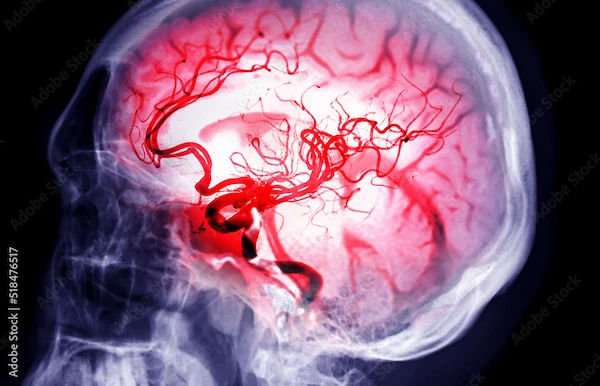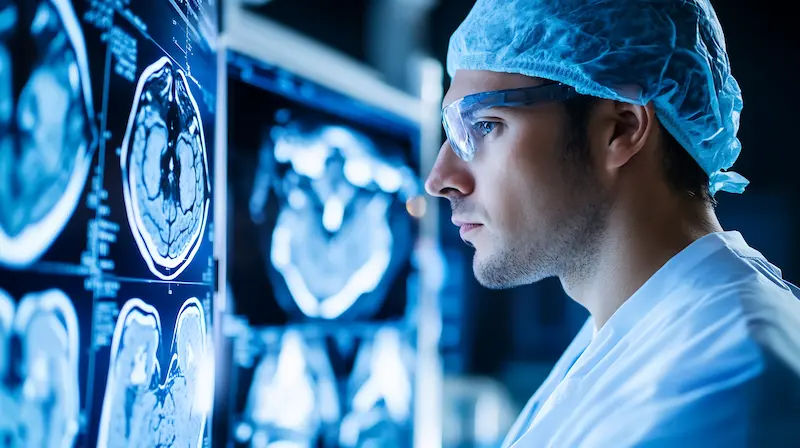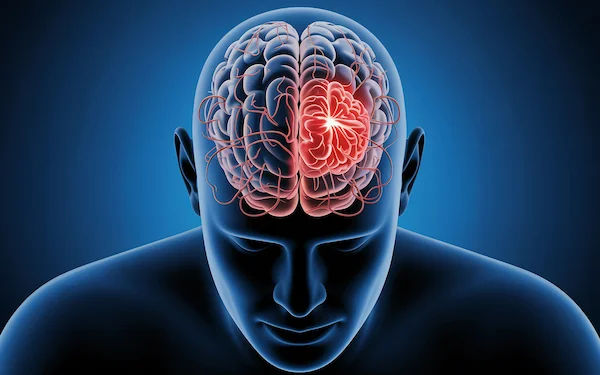Stroke Symptoms, Causes, and Recovery: A Complete Guide
Know about the stroke, what it is, causes, symptoms, diagnosis, treatment options and prevention of stroke.

Written by Dr. J T Hema Pratima
Reviewed by Dr. Rohinipriyanka Pondugula MBBS
Last updated on 21st Sep, 2025

Introduction
A stroke is a medical emergency that strikes every two seconds, somewhere in the world. It occurs when the vital blood supply to part of your brain is interrupted or reduced, preventing brain tissue from getting oxygen and nutrients. Within minutes, brain cells begin to die. This makes swift action absolutely critical. The aftermath of a stroke can be life-altering, affecting mobility, speech, and cognition. However, knowledge is power. Understanding what a stroke is, how to spot its warning signs using the FAST test, and knowing its underlying causes can literally save a life—maybe your own or that of a loved one. This comprehensive guide will walk you through everything you need to know about strokes, from immediate recognition and emergency treatment to the long road of stroke rehabilitation.
What is a Stroke? The Brain Under Attack
At its core, a stroke is a "brain attack." It’s a disruption of the brain's blood supply, and the type of disruption defines the kind of stroke. Quick diagnosis of the type is essential for determining the correct emergency treatment.
Consult Top Specialists for Personalised Tips
Ischemic Stroke: The Blocked Artery (Clot)
Accounting for about 87% of all strokes, an ischemic stroke is the most common type. It happens when a blood clot blocks or plugs an artery leading to the brain. The clot can form directly in the brain's blood vessels (thrombotic stroke) or travel from elsewhere in the body, such as the heart, and lodge in a narrower brain artery (embolic stroke). This blockage starves brain cells of oxygen, leading to their rapid death.
Hemorrhagic Stroke: The Burst Artery (Bleed)
A hemorrhagic stroke is less common but often more deadly. It occurs when a weakened blood vessel in the brain ruptures and bleeds into the surrounding tissue. The accumulated blood compresses brain structures, causing damage. The two main types are intracerebral haemorrhage (bleeding within the brain) and subarachnoid haemorrhage (bleeding on the brain's surface). High blood pressure and aneurysms (weak spots in blood vessel walls) are common causes.
TIA (Transient Ischemic Attack): The Warning Stroke
Often called a "mini-stroke," a Transient Ischemic Attack (TIA) is caused by a temporary clot. The key difference is that the symptoms of a TIA are short-lived, often resolving within an hour, and cause no permanent damage. However, a TIA is a major red flag—it's a strong warning that a full-blown ischemic stroke may be imminent. Ignoring it is extremely dangerous.
Act F.A.S.T.: Recognising the Signs of a Stroke
Time lost is brain lost. Recognising the signs of a stroke and calling emergency services immediately is the single most important factor in determining outcomes. Remember the acronym F.A.S.T.:
F - Face Drooping: Does one side of the face droop or is it numb? Ask the person to smile. Is the smile uneven?
A - Arm Weakness: Is one arm weak or numb? Ask the person to raise both arms. Does one arm drift downward?
S - Speech Difficulty: Is speech slurred, strange, or hard to understand? Ask the person to repeat a simple sentence.
T - Time to call emergency services: If you see any of these signs, even if they go away, call for an ambulance immediately. Note the time when the symptoms first appeared.
Lesser-Known Symptoms in Women and Men
While F.A.S.T. covers the major signs, strokes can present with other symptoms, which are more frequently reported by women but can occur in anyone:
Sudden numbness or weakness in the leg.
Sudden confusion, trouble understanding, or disorientation.
Sudden trouble seeing in one or both eyes.
Sudden trouble walking, dizziness, loss of balance, or lack of coordination.
Sudden severe headache with no known cause.
What Causes a Stroke? The Underlying Triggers
Strokes don't happen without cause. They are typically the result of a combination of risk factors that build up over time.
Key Risk Factors You Can't Control
Age: The risk of stroke doubles for each decade after age 55.
Family History: Your risk is higher if a parent, grandparent, or sibling has had a stroke.
Race: African Americans have a higher risk of stroke and death from stroke than Caucasians.
Sex: Women have more strokes than men and are more likely to die from them. Factors like pregnancy, birth control pills, and hormone therapy can increase risk.
Previous Stroke or TIA: Having one significantly increases your risk of having another.
Lifestyle and Health Conditions You Can Manage
This is where you have the most power. The leading causes of an ischemic stroke are often manageable medical conditions:
High Blood Pressure (Hypertension): This is the single most important controllable risk factor.
Smoking: Nicotine and carbon monoxide damage the cardiovascular system.
Diabetes: High blood sugar increases the risk of clots and damages blood vessels.
High Cholesterol: Leads to the buildup of plaque in arteries (atherosclerosis), which can narrow or block them.
Atrial Fibrillation (AFib): An irregular heartbeat that can cause blood clots to form in the heart, which may then travel to the brain.
Physical Inactivity and Obesity.
How is a Stroke Diagnosed and Treated?
Emergency Diagnosis: CT Scans and MRIs
Upon arrival at the hospital, the emergency team must quickly determine the type of stroke. A CT scan is usually the first test to rule out bleeding (haemorrhage). An MRI can provide a more detailed picture of the brain. Other tests may include a carotid ultrasound to check neck arteries and an echocardiogram to look for heart clots.
Immediate Treatment: Clot-Busting Drugs and Surgery
For an ischemic stroke, the goal is to restore blood flow.
tPA (Tissue Plasminogen Activator): A clot-busting drug that can dissolve the clot causing the stroke. It must be administered within a narrow 4.5-hour window from the start of symptoms to be most effective.
Thrombectomy: A procedure where a doctor threads a catheter to the brain to mechanically remove the clot. This can be effective up to 24 hours after symptom onset for some patients.
For a hemorrhagic stroke, the focus is on controlling the bleed.
Treatment may involve drugs to reduce blood pressure and prevent seizures.
Surgery may be needed to repair blood vessel defects like aneurysms or to relieve pressure on the brain.
The Road to Recovery: Life After a Stroke
Stroke recovery is a lifelong journey that begins the moment the patient is stabilised. The brain has a remarkable ability to heal and rewire itself (neuroplasticity), especially with dedicated effort.
Stroke Rehabilitation Therapies
Rehab typically involves a team of specialists:
Physical Therapists: Help patients relearn movement, coordination, and balance.
Occupational Therapists: Help patients relearn everyday activities like eating, dressing, and bathing.
Speech-Language Pathologists: Help patients recover speech and language skills and address swallowing problems.
Coping with Emotional and Cognitive Changes
Beyond physical challenges, many survivors experience depression, anxiety, frustration, and personality changes. Cognitive functions like memory, judgment, and attention can be impaired. Support from mental health professionals, support groups, and family is crucial for holistic life after a stroke recovery.
How to Prevent a Stroke: Proactive Measures?
Up to 80% of strokes are preventable. Prevention is your best defense.
Diet and Exercise for a Healthy Brain
Follow a diet low in saturated fat, trans fat, and cholesterol and high in fibre. The DASH (Dietary Approaches to Stop Hypertension) and Mediterranean diets are excellent models.
Aim for at least 150 minutes of moderate-intensity aerobic activity (like brisk walking) every week.
Managing Chronic Conditions
This is non-negotiable. Work closely with your doctor to:
Control High Blood Pressure: This is the biggest priority.
Manage Diabetes: Keep your blood sugar within the target range.
Lower Cholesterol: This may involve diet, exercise, and medication.
Treat Atrial Fibrillation: Blood thinners are often prescribed to prevent clot formation.
If you have conditions like hypertension or AFib, consistent monitoring and management are key. Consult a doctor online with Apollo24|7 to create a personalised prevention plan and manage your prescriptions effectively.
Conclusion
A stroke is a sudden and devastating event, but it is not always inevitable or insurmountable. Empowerment through knowledge is our greatest tool. By memorising the F.A.S.T. acronym, you become a first responder capable of saving a life. By understanding the risk factors especially those within your control, like hypertension and lifestyle choices you can take proactive steps to protect your brain health for years to come. For survivors and their families, the path of stroke rehabilitation is challenging but filled with hope and the potential for remarkable recovery. If you have any concerns about your stroke risk factors, such as high blood pressure, don't wait. Book a physical visit to a doctor with Apollo24|7 for a comprehensive health assessment.
Consult Top Cardiologists
Consult Top Specialists for Personalised Tips

Dr. Tripti Deb
Cardiologist
40 Years • MBBS, MD, DM, FACC, FESC
Hyderabad
Apollo Hospitals Jubilee Hills, Hyderabad
Dr Moytree Baruah
Cardiologist
10 Years • MBBS, PGDCC
Guwahati
Apollo Clinic Guwahati, Assam, Guwahati

Dr. Zulkarnain
General Physician
2 Years • MBBS, PGDM, FFM
Bengaluru
PRESTIGE SHANTHINIKETAN - SOCIETY CLINIC, Bengaluru

Dr. Janjirala Seshivardhan
Cardiologist
7 Years • MBBS,DNB(GM),DM(Cardiology)
Manikonda Jagir
Apollo Clinic, Manikonda, Manikonda Jagir

Dr Nazneen Khan
Cardiologist
7 Years • M.B.B.S, M.D (MEDICINE), DrNB CARDIOLOGY
Pune
Apollo Clinic, Viman Nagar, Pune
Consult Top Cardiologists

Dr. Tripti Deb
Cardiologist
40 Years • MBBS, MD, DM, FACC, FESC
Hyderabad
Apollo Hospitals Jubilee Hills, Hyderabad
Dr Moytree Baruah
Cardiologist
10 Years • MBBS, PGDCC
Guwahati
Apollo Clinic Guwahati, Assam, Guwahati

Dr. Zulkarnain
General Physician
2 Years • MBBS, PGDM, FFM
Bengaluru
PRESTIGE SHANTHINIKETAN - SOCIETY CLINIC, Bengaluru

Dr. Janjirala Seshivardhan
Cardiologist
7 Years • MBBS,DNB(GM),DM(Cardiology)
Manikonda Jagir
Apollo Clinic, Manikonda, Manikonda Jagir

Dr Nazneen Khan
Cardiologist
7 Years • M.B.B.S, M.D (MEDICINE), DrNB CARDIOLOGY
Pune
Apollo Clinic, Viman Nagar, Pune
More articles from Stroke
Frequently Asked Questions
Can a stroke be cured?
While there is no singular 'cure' for the damage caused by a stroke, emergency treatments like tPA and thrombectomy can stop a stroke in its progress and drastically reduce long-term disability. The brain can then heal through rehabilitation, but recovery varies greatly from person to person.
What is the difference between a stroke and a heart attack?
A heart attack is a blockage of blood flow to the heart muscle. A stroke is a blockage or bleed affecting the brain. Both are medical emergencies caused by problems in blood vessels.
How long does stroke recovery take?
The most rapid recovery usually occurs in the first three to six months. However, patients can continue to improve for years through consistent therapy and practice. Recovery is a marathon, not a sprint.
Are the signs of a mini-stroke different from a major stroke?
No, the signs of a mini-stroke (TIA) are identical to those of a major stroke. The only difference is that the symptoms of a TIA are temporary and resolve completely, usually within an hour. They should never be ignored.
Can young people have strokes?
Yes. While risk increases with age, strokes can occur at any time, including in children and young adults. Factors like congenital heart defects, clotting disorders, substance abuse, and trauma can cause strokes in younger populations.


.webp)

